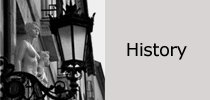
|

|

|

|

|

|

|

|

|
The evolution of the city
- Salamanca in the Universal History
- Ancient History
- Medieval History
- Modern History
- Contemporary History
Salamanca in the Universal History
Salamanca is linked to the Universal History due to many facts and personalities, who have changed and shook up the evolution of the Occidental society:
- The creation of the first Castilian Grammar in 1492 by Antonio de Nebrija. It was the first book, which resumed all the rules about a European language, apart from the Latin. Due to this book began "The golden Spanish century".
- Antonio de Nebrija has been the first man of the Occidental world who claimed the rights for the authors.
- The preparations of Christopher Colombus for his first trip to discover America. The cloister of the University of Salamanca joined together in council to talk about his project. During these years, Colombus gained the support of the Dominicans and stayed at the Convent of San Esteban. The astronaut Abraham Zacutowas was his biggest scientific support.
- The first Academic woman in the world: Beatriz Galindo, "la Latina".
- The first Academic teacher in the world: Lucía de Medrano, during the academic year 1508-1509.
- The years of studies of Hernán Cortés before going to America and conquering the Imperio Azteca.
- The defense of the rights of the Indigenes in the New World, with Francisco de Vitoria as the chief. He reformulated the concept of Natural Rights, renewed technologies, laid the foundations of modern people, international rights and the modern economic science and participated in the council of Trento.
- In this council, the mathematicians of the University of Salamanca proposed to Papa Gregorio XIII a calendar, which is the Gregorian one. Today, it still used in the whole world.
- The fact that the first librarian with wage was in the library of Salamanca.
- The translation of the Holy Bible by a Spanish man: Fray Luis de León.
- The oldest preserved book about chess, Repetition of Loves and Art by Luis Ramírez de Lucena, published in Salamanca in 1496.
- The stay of Miguel de Cervantes Saavedra, who probably studied at the University, has been materialized in his books: the cave of Salamanca, with Don Quijote de la Mancha. He makes references to Salamanca and to the character of Bachiller Sansón Carrasco, and the academic Vidriera.

Ancient History
Los vaceos were there more than los vetones, who had a strong presence in the zone of the actual provinces of Avila, Toledo and Salamanca.
In the 3rd century, Aníbal took the antique city of Helmántica (Salamanca). The legend says that the citizens of Salamanca paid for the place without resistance and then left the city. However, the women had with them the men’s weapons and armed, they came back and besieged the Carthaginians inside of the city.
With the fall of the Carthaginians, the Romans reinforced their occupation of the city and Salamanca began to be important. Because of this occupation, a business enclave appeared, due to its privileged position as a solution for the Tormes River, which, in its turn, has been transformed into one of the most important Roman roads of Hispania, la Vía de la Plata. Because of this, the Roman Bridge was built during the 1st century. Today, only the North part is still up (the other half had to be rebuilt during the 17th century after the flood of San Policarpo).

Medieval History
At the end of the Roman age, the mastiffs moved to Lusitania and the city became a part of this region. Then the Visigoths conquered the city and added it to their territory. We don’t have a lot of information about the development of Salamanca in the Visigoth period. We only know that, during the 4th century, the Roman wall was extended. We also know that, in 1589, the city was base between the cities, which sent bishops to the councils of Toledo.
During the year 712, because of the Muslim invasion of the peninsula, Musa ibn Nusair conquered the city. In the middle Ages, the zone stayed as “the earth of nobody”. Salamanca was reduced to an unimportant core and almost uninhabited. Alfonso I in 754, ultimately obliterated what remained of the city.
The zone stayed uninhabited until the Christian victory, with the battle of Simancas in 939.Then began a little revolt on the riverbank of the Tormes, which didn’t have any success against the powerful Califato.
The repopulation of the city happened after the conquest of Todelo by Alfonso VI, in 1085. In 1102, Raimundo de Borgoña went towards the city with a large group of people from different origins, by order of his father-in-law, Alfonso VI. French’s, Highlanders, Castellans, Portuguese, Toresanos, Jews and Galicians founded their own Parish churches. The Diocese was restored and the construction of the cathedral began. Afterwards, a few schools appeared and will become, in the future, the start of the future University.
During the year 1230, the reign Fernando III El Santo lost his importance and the kingdoms of Castile and Léon definitely joined together.
During the 13rd century, the Monarch Alfonso IX of Leon conceded to the schools of the cathedral the rank of General Study, which, in 1253, was changed into the University of Salamanca as a real document of Alfonso IX, later ratified by the Father Alejandro IV (1255). The University was reaching, with the time, a real and high prestige.
The 12th August 1311, the only king of Castile and Leon was born, which gave the name to the city Alfonso XI el Justiciero. He took place on the throne at the age of fourteen and conquered Gibraltar against the militia Castellano-Leonesas, who stand out refused the large presence of the Salmantinian contingents.
During the 15th century, strong rivalries between the noble families in Salamanca were present in the city, who divided the city in two parts (one part for each family): San Benito and Santo Tomé. With the rise of the Mesta, Salamanca became an important center of bread baskets manufactures and a famous wool exporter.

Modern History
Salamanca joined the movement The Communities of Castile (1520) against the new taxes that wanted Carlos I in the Parliament and defended its manufacture of textiles against the privileges of the wool exporters. After the defeat of the Comuneros, the King Carlos I made lopped all the towels of the Salmantinian palaces, which followed the revolt.
The 16th century was the period of the most beautiful splendor of the city, first due to its demography and second to its life of the University, thanks to the prestige of the teachers, with the Designation School of Salamanca.
After, Salamanca joined the general decadence of the cities of the Crown of Castile to the North tableland/landing (12.000 citizens in 1651).
During the 18th century, there was an important economic and cultural rebirth which proposed to end the construction of the New Cathedral and the Plaza Mayor (baroque) in 1729 and make relive the monuments which were broken because of the earthquake of Lisbon in 1755. In the history of the culture, it is important to notice the influence of the illustration of the Borbones to the University during the last third of the century.

Contemporary History
During the Independence War, Salamanca was occupied by the troops of the Mariscal Soult in 1809 and stayed in the French’s hands until the battle of the Arapiles (1812), in which the allied armies defeated under the command of Wellington.
During the occupation, the French built their defenses and, to get the materials, destroyed a big part of the Salmantinos buildings, specially in the area of the Caídos, where have been built famous colleges of the University (which we don’t have any traces about). When Fernando VII closed all the Universities in Spain, which was the worst moment ever. Since the reopening, the University of Salamanca has been reduced to a provincial University.
In 1873, after the proclamation of the First Republic, Salamanca knew a Cantonalista uprising, which was terrible.
During the 19th century, the city experimented a slight recovery (to be named by the capital of the province) and built the railways which links France and Portugal, and which pass through the Meseta.
During the civil war, between October 1936 and November 1937, The Episcopal Palace was the residence and the control center of the Franco General.
After the war, the documents (confiscated by the rebel army as they were occupying the territory) have been kept in Salamanca. According to this, a big documental file about the Spanish Civil War was created (General files of the Spanish Civil War). The part of this file belonging to Castilian has been transferred to Barcelona during the springtime 2006. The hall town of Salamanca, presided by Alfonso Fernández Mañueco (PP), changed the name of the street where there was the archive of Gibraltar "The plunder", as a sign of protestation after the transfer of the "papers of Salamanca" to Cataluña.
In 1940, Pío XII founded the Pontificial University of Salamanca as the continuation of the studies of Theology.
In 1988 Salamanca is announced The Patrimony City of the Humanity by the Unesco. In 1998, by agreement of the Ministers of the Culture of the EU, Salamanca becomes the European Capital of Culture in 2002. The city would like to get the candidature to the Exposition of Salamanca, in a future not so far away.















 info@ciudaddesalamanca.es
info@ciudaddesalamanca.es